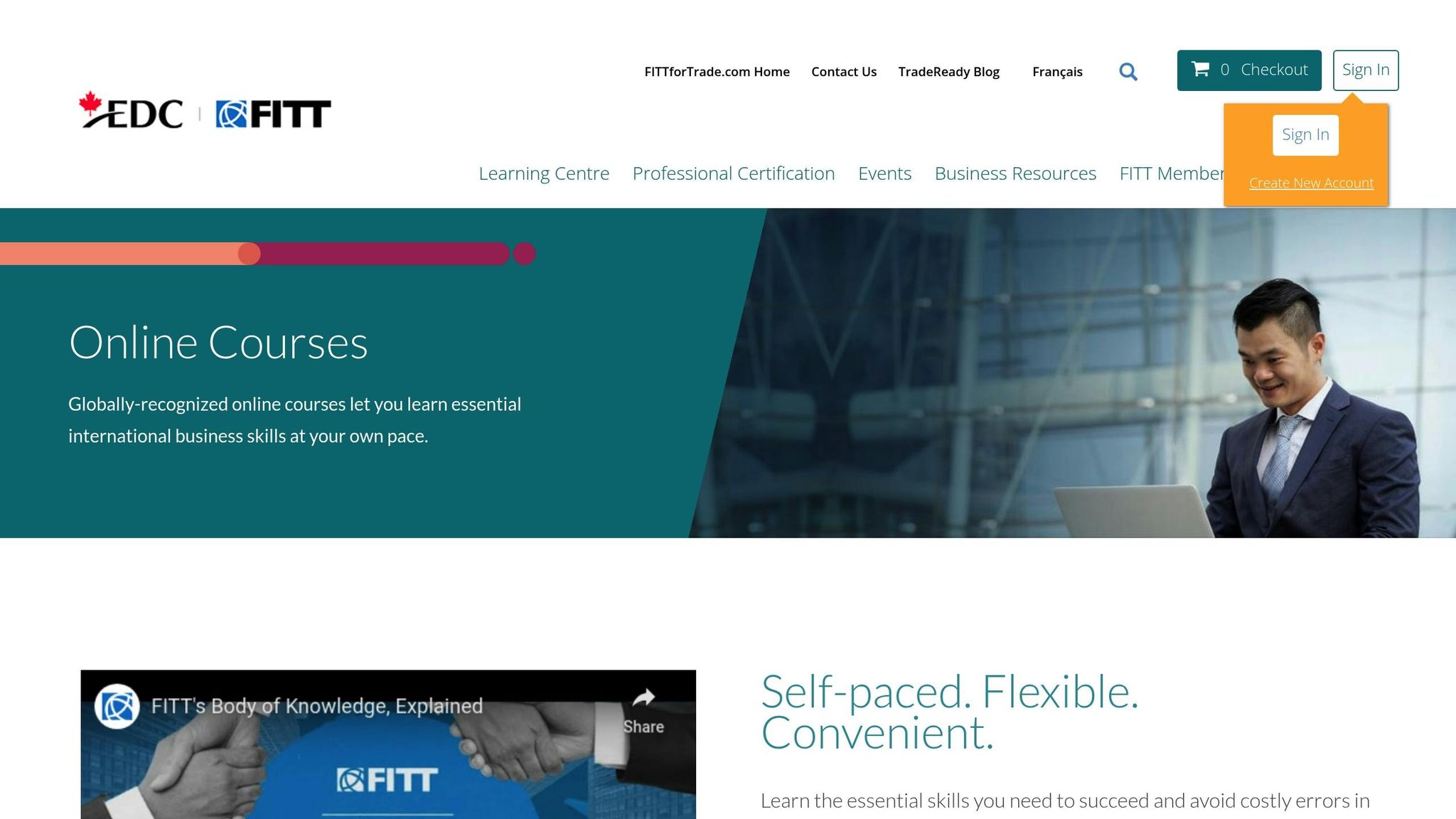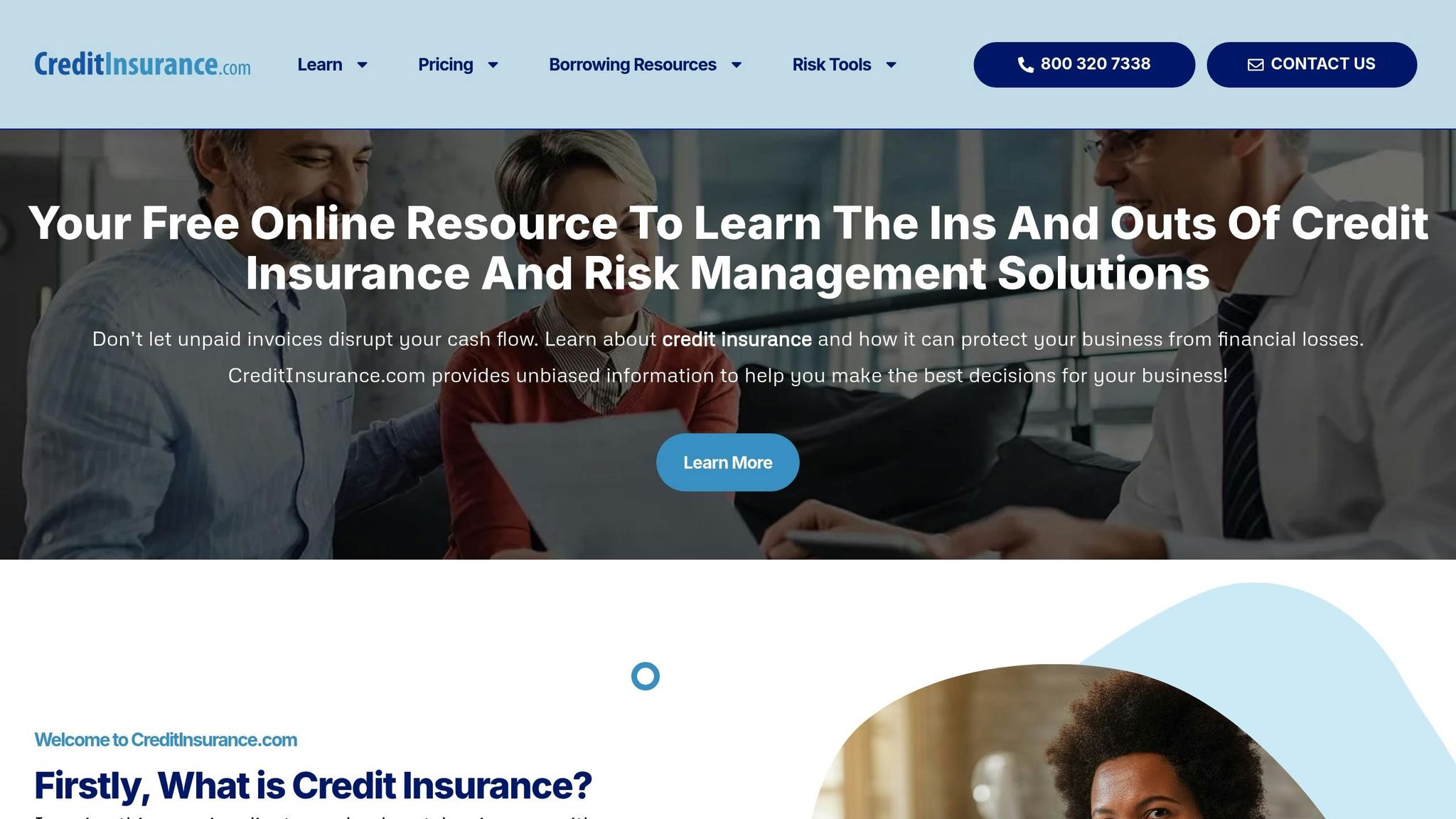International trade offers growth opportunities but comes with risks like political instability, currency fluctuations, and buyer defaults. Underwriters help businesses navigate these challenges by evaluating risks and offering solutions to protect financial stability.
Key Points:
- Risks in Trade: Currency changes, political unrest, credit defaults, and regulatory shifts.
- Role of Underwriters: Assess potential risks, structure deals, and suggest mitigation strategies (e.g., credit insurance).
- Modern Tools: AI, big data, and predictive analytics improve risk detection and decision-making.
- Risk Mitigation Methods: Hedging, credit insurance, and milestone-based payments.
- Credit Insurance Benefits: Protects businesses from losses, improves cash flow, and simplifies financing.
Underwriters provide expertise and tools to reduce uncertainties, allowing businesses to confidently expand into international markets.
The 3 kinds of risks in international trade finance. – FITTskills online.
5-Step Process for Assessing International Trade Risk
Underwriters follow a detailed five-step process to evaluate risks in international trade and make informed decisions. Here’s how they translate risk assessment into actionable underwriting strategies.
Step 1: Identify Key Risk Factors
The process begins with pinpointing all risks that could affect the trade. Underwriters look at both macroeconomic and microeconomic factors. Macroeconomic risks include issues like regulatory shifts, market instability, political unrest, and currency fluctuations – factors that impact entire regions or countries. On the other hand, microeconomic risks focus on specific companies, such as operational inefficiencies, liquidity concerns, and credit risks.
They also assess strategic and reputational risks, along with extraordinary events. Political factors, such as corruption, economic disparity, instability, and terrorism in the buyer’s country, are given special attention.
Federico Monti, Senior Risk Underwriter and Export Import Manager at Allianz Trade in Italy, describes the importance of staying ahead of global developments:
"It is my responsibility to understand what is going on in countries in the world. It requires continual effort to try to anticipate future scenarios and what challenges these might present for our customers."
Step 2: Collect and Analyze Data
Once risks are identified, underwriters gather critical data from sources like credit reports, financial statements, and other records. Modern tools like automation and big data play a central role in this phase, helping underwriters make informed decisions. A common framework used in creditworthiness evaluations is the "5 Cs".
Allianz Trade’s proprietary intelligence network exemplifies the scale of this analysis. Monitoring daily changes in corporate solvency across 92% of the global GDP, it provides underwriters with a massive pool of real-time data.
Step 3: Conduct Due Diligence
Due diligence ensures that all information is verified and that businesses meet legal and regulatory requirements. This involves reviewing credentials, compliance, and resilience, often through direct communication with management teams. Financial metrics like liquidity ratios and debt service coverage are analyzed to gauge a company’s ability to weather economic challenges.
Legal due diligence is equally important. It ensures contracts are aligned with both local regulations and international laws, clarifying obligations and establishing mechanisms for dispute resolution. This comprehensive review lays the groundwork for effective risk management.
Step 4: Apply Risk Mitigation Methods
With risks identified and analyzed, underwriters implement strategies to reduce exposure. These may include hedging, diversification, political risk insurance, or credit insurance. For high-risk transactions, enhanced monitoring systems might be recommended – such as milestone-based payments, regular financial updates, or early warning indicators to catch emerging problems.
Collaboration between underwriters and claims assessors is key to refining these strategies. Andy J. Arduini of Huntington Bank highlights the limitations of even the best mitigation plans:
"Be mindful that even the best constructed hedging strategy provides no assurances of payment. Companies operating abroad will still face credit and country risks with which they will need to contend."
Step 5: Structure and Finalize the Decision
The final step involves setting terms, pricing, and coverage limits based on the assessed risks. Underwriters carefully balance risk exposure with business goals. Higher-risk transactions often come with higher premiums or stricter terms. Coverage limits are determined by the buyer’s financial strength and the political climate of their country.
To further minimize risks, conditions like regular reporting or collateral requirements may be imposed. Final approval often involves input from senior underwriters, risk committees, and sometimes external experts, ensuring rigorous scrutiny of complex trade risks.
Jason Robinson, Head of Special Risks Unit at Allianz Trade in the UK and Ireland, underscores the value of their approach:
"The network of information and the scale of data that we gather through our risk analysis at Allianz Trade is second to none. And it’s one of the key advantages for our customers."
"What we bring to the customer is better-informed decisions and a trusted partner they can discuss with."
Modern Tools and Techniques in Risk Assessment
Technology has transformed risk assessment by replacing manual document reviews with advanced systems capable of processing data instantly. Gone are the days when basic financial analysis was the cornerstone of risk detection. Today, sophisticated tools analyze immense data sets in real time, delivering faster, more precise decisions while uncovering risks that may have slipped through the cracks with older methods. This evolution has paved the way for the integration of big data and predictive analytics into the risk assessment process.
Using Big Data and Predictive Analytics
Big data and predictive analytics are reshaping the way underwriters evaluate trade risks. These tools provide the ability to quickly adapt to the ever-changing dynamics of global trade and uncover illicit trade patterns that might otherwise go unnoticed. Given the complexity of international trade – with its numerous parties, vast documentation, and countless data points – manual reviews simply can’t keep up.
AI and machine learning are at the heart of this transformation. Underwriters now use these technologies to analyze complex data streams and predict potential risks before they arise. Predictive analytics highlights emerging risks, while prescriptive analytics offers actionable strategies to address them.
Take India’s National Customs Targeting Centre (NCTC) as an example. The NCTC has significantly enhanced its ability to identify high-risk shipments by leveraging AI-powered tools. These include x-ray image analytics and real-time dashboards that allow customs officials to target risky shipments with remarkable efficiency.
Modern tools go even further, employing a range of techniques to improve risk assessment. These include:
- Supply chain risk mapping: Using supplier codification to identify vulnerabilities.
- Network analysis: Offering a holistic view of interconnected risks.
- Mirror analysis: Comparing a country’s import data with its trading partners’ export data to spot discrepancies.
- Time series analysis: Detecting abnormal surges in trade activity, which can signal fraud.
- AI-based optical character recognition (OCR): Extracting key data from documents to identify mismatches between declared and actual cargo contents.
These tools also analyze historical data to assess financial health, looking at factors like liquidity, debt, and profitability to provide a complete picture of a supplier’s stability. By continuously monitoring these indicators, modern systems deliver a thorough and dynamic view of financial risks.
Comparing Old vs. Data-Driven Methods
The difference between traditional and modern risk assessment methods is stark. Traditional approaches relied heavily on manual document reviews and physical inspections, often leading to slower processes and limited insights. In contrast, today’s methods harness the power of AI, machine learning, and data analytics to process massive amounts of information with speed and precision.
This shift has produced tangible results. Insurers using advanced data analytics in underwriting have reported a 10–15% increase in business premiums, a 3–5 point improvement in loss ratios, and up to a 10% rise in retention within profitable segments.
Here’s a side-by-side comparison of the two approaches:
| Aspect | Traditional Methods | Data-Driven Methods |
|---|---|---|
| Data Processing | Manual review of documents and financial data | AI and machine learning analyze vast structured and unstructured datasets |
| Speed | Slow, prone to errors and delays | Real-time processing with instant risk scoring |
| Risk Detection | Limited to obvious, historical patterns | Identifies hidden patterns and emerging risks |
| Pricing | Static, based on broad categories | Personalized pricing tailored to specific risk profiles |
| Adaptability | Relies on historical data | Forward-looking and responsive to new risks |
| Scope | Siloed, department-specific analysis | Comprehensive, enterprise-wide risk assessment |
The impact of these advancements is evident in the speed and accuracy of decision-making. McKinsey forecasts that by 2030, AI automation will enable insurance underwriting to be completed in mere seconds – without sacrificing precision. Modern systems achieve this by simultaneously processing multiple variables and cross-referencing diverse data sources.
The real-world benefits are equally compelling. Allianz, for instance, implemented an AI-powered fraud detection system called Incognito, which has already saved $1.7 million and holds an additional $3.4 million in claim reserves awaiting investigation. The system has boosted application fraud savings by 150%, with one notable case preventing a $21,000 payout for a staged accident.
Despite these advancements, there’s still room for growth. Only 8% of companies currently utilize dedicated compliance software. In 2023, risk management ranked among the least implemented measures in the WTO Trade Facilitation Agreement Database, with global progress at just 63.7%. For underwriters, this gap represents both a challenge and an opportunity to gain a competitive edge through enhanced risk assessment tools and techniques.
sbb-itb-b840488
Using CreditInsurance.com for Risk Management
In today’s world, where advanced analytics and AI tools are reshaping how underwriters evaluate international trade risks, businesses still need practical tools to manage those risks effectively. This is where CreditInsurance.com steps in, offering businesses actionable insights that make complex underwriting decisions more understandable and easier to act on.
The platform recognizes the increasing rate of business insolvencies caused by global challenges. This makes it even more important for companies to assess their risk exposure and explore available protection options. CreditInsurance.com provides impartial guidance, helping businesses navigate these risks while aligning with the modern underwriting practices discussed earlier.
Educational Resources for Credit Insurance
CreditInsurance.com goes beyond just offering services – it also educates businesses on credit insurance and accounts receivable protection. Through its blog, the platform provides detailed articles that break down various aspects of credit insurance and international trade risks, complementing the advanced risk assessment techniques employed by today’s underwriters.
The platform emphasizes the critical role of credit insurance for companies operating on open account terms, particularly those entering new markets or dealing with customers who have limited credit histories. These educational resources not only explain what credit insurance covers but also highlight its importance in safeguarding businesses as they expand into international markets.
One standout feature is the platform’s clear guidance on pricing. For domestic insured sales, premiums typically range from $0.10 to $0.20 per $100, while export insured sales range from $0.20 to $0.30 per $100. Additionally, credit insurance can provide advance rates of up to 90% on both domestic and export sales, improving cash flow and making it easier for businesses to secure favorable financing terms.
To help businesses find the best solutions, CreditInsurance.com connects them with industry specialists who can recommend tailored credit insurance plans and compare pricing options.
Case Studies and Practical Insights
CreditInsurance.com enhances its educational offerings with real-world examples, showcasing how credit insurance can be a powerful tool for managing risk and supporting international growth. The platform shares case studies that highlight how customized credit insurance solutions have helped businesses expand globally while mitigating financial risks.
One client shared their perspective on the value of trade credit insurance:
"In my mind, accounts receivable is the biggest asset you have in a services business like ours, and that is the one thing that a business is often not insuring. It doesn’t make any sense. I think trade credit insurance is worth every penny."
These real-world insights demonstrate how credit insurance can shield businesses from financial losses and promote growth across various industries. By combining practical tools, expert advice, and educational resources, CreditInsurance.com equips businesses with the knowledge and support they need to navigate today’s complex trade environment.
Conclusion and Key Takeaways
Understanding how underwriters assess international trade risks is crucial for safeguarding and expanding your business on a global scale. The detailed evaluation process we’ve discussed highlights that successful international trade involves much more than simply securing overseas customers.
Breaking Down the Risk Assessment Process
The five-step underwriting process – covering everything from identifying risks like political instability and currency fluctuations to conducting thorough due diligence on buyers – creates a well-rounded risk profile for international transactions.
Today’s underwriters use tools like big data and predictive analytics to enhance traditional methods, offering faster and more precise risk insights. This shift underscores the importance of staying updated with these evolving approaches to remain competitive in global markets.
The benefits of proactive risk management are clear. By planning for potential incidents and regularly updating risk strategies, businesses can significantly reduce their losses. These practices are essential for tackling the unique challenges of international trade and ensuring smoother operations.
These principles also pave the way for using credit insurance as an added layer of protection against global trade risks.
Credit Insurance: A Smart Next Step
Building on the insights gained from a thorough risk assessment, credit insurance serves as an additional safeguard for your international ventures. This tool, backed by underwriting expertise, helps you make informed decisions about managing credit risks in global trade.
Proactive risk management allows businesses to take calculated risks that can lead to substantial rewards. It minimizes disruptions, strengthens financial stability, and protects your brand’s reputation. Additionally, it enables companies to offer extended credit and flexible payment terms, fostering growth and strengthening business relationships.
Relying on hope alone won’t shield your business from export risks. Credit insurance bridges the gap between understanding risks and managing them effectively. It provides an affordable safety net against potential losses from uninsured international transactions.
FAQs
How do AI and big data improve risk assessment in international trade underwriting?
AI and big data are transforming how risk is assessed in international trade underwriting, offering underwriters sharper insights and quicker decision-making tools. By examining extensive trade data, credit histories, and market trends, these technologies help pinpoint risks with a level of accuracy and efficiency that was previously hard to achieve.
AI allows underwriters to dive into key factors like buyer creditworthiness, political instability, and shifting market conditions with a higher degree of precision. Meanwhile, big data enhances forecasting and trend analysis, cutting through uncertainty and enabling smarter strategies to manage risks. The combination of these tools not only improves the accuracy of underwriting but also speeds up workflows and opens doors for business expansion.
What are the main advantages of using credit insurance for businesses in international trade?
Credit insurance provides businesses involved in international trade with a safety net against non-payment risks, such as customer insolvency or other financial difficulties. By offering this layer of protection, companies can maintain steady cash flow and reduce the stress of financial unpredictability.
Beyond just protection, credit insurance opens doors for businesses to explore new markets or clients with greater confidence. With the assurance of coverage, extending credit becomes less risky. It also makes securing financing easier, as lenders often view insured receivables as more reliable assets. In essence, credit insurance not only safeguards your business but also supports its growth in today’s competitive global economy.
How do underwriters evaluate and manage risks in international trade?
Underwriters follow a five-step process to evaluate and manage risks in international trade. Here’s how it works:
- Identifying risks: Spotting potential threats such as buyer insolvency, political upheaval, or unpredictable market changes.
- Assessing risks: Examining how likely these threats are to occur and the potential impact they could have on trade deals.
- Responding to risks: Crafting strategies to reduce or address the risks identified.
- Communicating risks: Keeping stakeholders informed about risks so they can make well-informed decisions.
- Monitoring risks: Regularly revisiting and updating risk evaluations to keep up with changing circumstances.
This methodical framework helps businesses protect themselves from financial setbacks while building trust in international trade. For those wanting an extra layer of security, credit insurance can be a helpful option. It provides protection against risks like non-payment or political turmoil, making trade transactions smoother and opening doors to growth.




